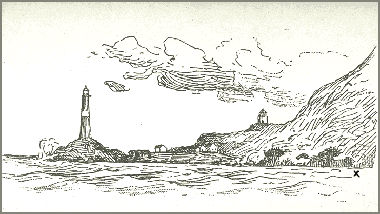

On the morning of 8 March 1725, inhabitants of the Goksøyr farm at Runde saw that a storm had washed some wreckage onto the shore. Fortuitously, the legislative assembly was to be held nearby and the chief administrative officer, Erik Must, was soon informed about the discovery of the wreckage. He sent his representatives to Runde to investigate.
 Read about:
Read about:
the Akerendam,
Salvage 1725,
Salvage 1972,
Overview, Cleaning
 C.F. Dirik, the lighthouse master, made this drawing from
Runde in 1869. A treasure-bearing ship was supposed to have foundered at
the spot marked by a cross. (In 1972, 32 of the Akerendam's cannons were
found here.)
C.F. Dirik, the lighthouse master, made this drawing from
Runde in 1869. A treasure-bearing ship was supposed to have foundered at
the spot marked by a cross. (In 1972, 32 of the Akerendam's cannons were
found here.)
"a large number of dead, naked bodies, all of them badly broken, and a sizeable quantity of personal goods and cargo, all in the same area."
Approximately 200 people were on board the Akerendam when it foundered, not one of whom survived.

